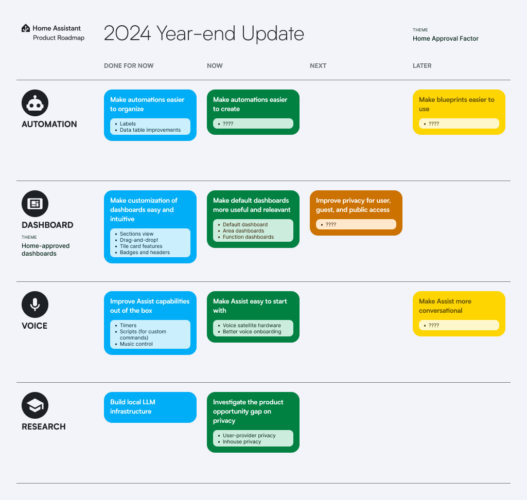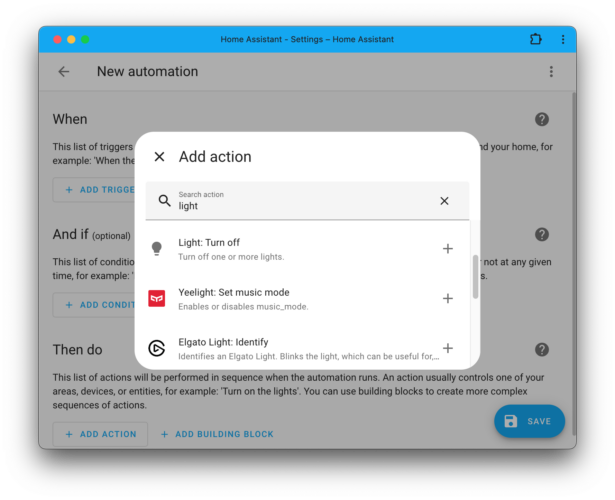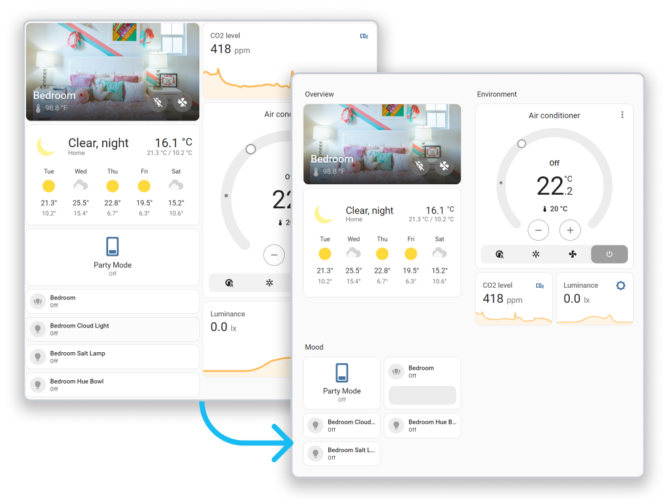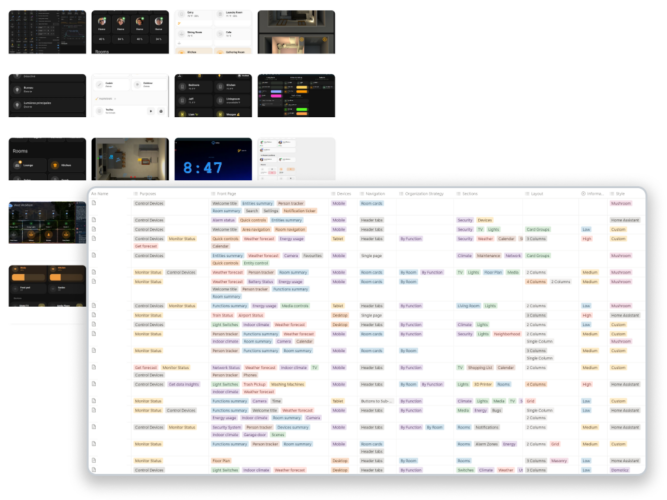The Home Assistant team followed a very precise roadmap for the development of its home automation solution, and has made remarkable progress in its execution. It is now tackling its next priorities.
The roadmap, first presented at the “State of the Open Home” in April, serves as a guideline for all product initiatives. This approach ensures consistency and a clear direction for all developments. The team has made significant progress on the targets set for 2024, thanks to the commitment of key maintainers and the invaluable support of Nabu Casa, the Open Home Foundation‘s business partner. The majority of planned initiatives have progressed according to schedule. A status update is scheduled every six months to keep the community informed of progress, demonstrating the team's commitment to transparency and dialogue with its users.

Home Assistant: “A smart home approved by the home”.
Home Assistant's strategic vision revolves around a fundamental objective: to maximize the adoption and daily use of the platform by all members of the household. This ambition is materialized by optimizing the key touch points of home automation, personalized dashboards and voice commands, with which every inhabitant naturally interacts on a daily basis. This balanced approach aims to harmoniously combine two crucial aspects: on the one hand, simplicity of use enabling every member of the family to intuitively appropriate the technology, and on the other, maintaining the advanced functionalities that are the platform's strength for expert users and administrators. This global strategy is deployed across various product categories, forming a coherent home automation ecosystem that combines accessibility and technical power.
Automation
Easier organization of automated systems
The ability to organize automations has long been one of the most requested functionalities by the Home Assistant community, which naturally made it a major priority in the platform's development. In response to this need, the team has implemented a flexible categorization system enabling users to classify their automations according to their own criteria, making them considerably easier to manage, edit, debug and search. This customizable approach offers a high degree of organizational freedom, enabling users to group automations by functionality, such as “Intelligent heating” or “Intelligent cleaning”, or to create specific categories such as “Tests” to isolate automations being tested in the home.

Beyond the categorization system, Home Assistant has enriched the management of automated devices with a labeling system similar to that used for the platform's other entities. This functionality is not limited to the simple filtering of automations, but opens the way to particularly innovative automation possibilities. A remarkable example observed in the community consists in identifying certain automations as “Not suitable for guests” via a dedicated label, enabling their automatic deactivation when guest mode is activated. This metareflexive approach, where labels are used to automate the automations themselves, perfectly illustrates the significant progress made by Home Assistant over the last six months to simplify and optimize the organization of automations.
New objective: Facilitate automation creation
Automations are one of the cornerstones of Home Assistant, but creating them isn't easy, especially if you're just starting out. There are a dozen things to know before you start, and a dozen things to learn along the way.

Last year, the team overhauled the action selector and replaced a single, obscurely named option, “Call Service”, with hundreds of carefully categorized entries they called “Actions”. This significantly improved the automation creation process.
But today, the automation editor gives the impression of having progressed at two different speeds; actions are easy to use, but triggers and conditions are not. So they've started to bring the same level of convenience to triggers and conditions that they brought to actions.
The aim is to make the automation editor more accessible without losing what makes it unique: its capabilities.
Next: Make Blueprints easy to use
Blueprints are amazing, and they represent what makes the Home Assistant community so great: sharing what you've learned with others.
But using (and sharing) blueprints isn't the easiest process today. For now, it's the next opportunity the team wants to address as part of the automation flow.
Dashboards
Making dashboard customization easy and intuitive
With the stable release of the new section layout in Home Assistant 2024.11, work to make dashboard customization easier is now well underway! The learning curve for creating beautiful dashboards has been dramatically reduced, and more and more people are interested in and able to create high-quality dashboards usable by all members of the household.

But the work isn't over yet, and the group is currently working on standardizing the appearance of default charts.
Then making default dashboards more useful and relevant
Now that customizing dashboards is easier than ever, what's the next step? It can be intimidating for users to be faced with a blank page. Some may be full of ideas about how they'd like to fill their dashboards, but others would prefer Home Assistant to come with something useful ready to use. That's why developers are now looking to make dashboards easier to use, even if you don't know how to create one.

Over the past year, the team has looked at dozens of case studies – dashboards created by numbers of users, from the most popular to the most pragmatic – and they've started to notice trends in the way users organize their dashboards. Home Assistant is unique from other smart home platforms in that dashboards are not limited to device control. After all, the perfect app isn't an app, because opening an app to control your light bulb is less convenient than simply flipping a switch, or better still, automating it.
What they've noticed from users are dashboards that help them track the information of their daily lives at a glance, and keep an overview of everything that's going on in their home. For example, you can automate Home Assistant to alert you when energy consumption is too high, or you can ask Assist for current energy consumption, but dashboards stand out for their data visualization and their ability to provide you with a lot of the information you need at a glance.
Currently, the default dashboard simply groups all a home's entities together on a single page, making it extremely difficult to manage as the smart home grows. Although it can automatically group entities by zone, developers have learned that zones aren't the only way users view dashboard information. Instead, they've seen specialized dashboards focused on a home's functions, such as energy consumption, security and safety, and network status, on complex objects, such as a car and a 3D printer, or on information unrelated to the home itself, such as the weather, neighborhood information, or even rocket launches. While they could simply display each entity by domain, they know they can make these feature-driven dashboards much more useful by revealing information through selection and juxtaposition of information.
Next: Improve confidentiality of user, guest and public access
The inability to fine-tune access to Home Assistant by guests or other family members has been a pain point raised by many users. Developers are therefore keen to explore ways of mitigating this problem while improving privacy for family members.
Voice assistants
Enhancing assistant capabilities right out of the box
Assist, the private voice assistant in the Home Assistant solution, has received a lot of attention over the past six months. The first goal was to improve its capabilities right out of the box, without the need for tinkering. As a result, they've added a number of features much in demand by the community, features that bring them closer to parity with non-private competitors.
In particular, they've introduced zone awareness, which lets you target devices in the same zone without mentioning the zone (like “Close the curtains” or “Turn off the lights”). They've introduced floor support, which lets you target devices in zones on the same floor, which is very useful for open-floor homes (for example, “Turn on all lights on the second floor”).
They've implemented timers, allowing any voice assistant to “ring” when a timer ends, including support for creating multiple timers. They can also be paused and resumed, and time added or deleted. You can combine commands with timers by giving a deferred command, allowing you to perform an action after a certain time (such as “Turn off the TV in 30 minutes”).
They've also introduced the ability to control media by voice. Pause or resume them, control the volume and skip to the next track. This, combined with the aforementioned zone detection capability, has created some really interesting short commands that work in a room where the TV is on or music is streaming, such as “Pause”, “Resume” and “Next”.
Finally, the wake-up word engine on the device, called microWakeWord, has become much faster and much better at recognizing wake-up words. This is the result of using real voice data in the training process to refine the models. With Wake Word Collective, you can now contribute by lending your voice to the improvement of the community- and privacy-focused voice assistant! Find out more in this blog post.
In progress: Facilitating access to assistance
So, assistance is more powerful, but what about getting to grips with Voice?
Voice is difficult because it's a combination of great software and great hardware. Until recently, the team's main focus has been on improving the software experience and relying on readily available hardware to run voice assistants.
However, that's about to change: over the past 6 months, they've built their own hardware! This will be the first voice assistant hardware designed from the ground up to work with Home Assistant, entirely open source (firmware and hardware), and it will be released very soon (really very soon ;-). It really is the missing piece of hardware for a more accessible voice experience in Home Assistant.
Next: Make the Assistant more conversational
The more features we add to the Assistant, the more we reach its transactional limits. Indeed, today, an interaction is unidirectional, going from a user (who issues a command) to the Assistant (which acts on that command). Developers would like to improve this situation, by enabling more conversational interactions with Assist.
In future, the assistant will be able to ask for clarification before executing a command, for example, by asking for the duration of a timer if it was not part of the original command, or by requesting confirmation before executing critical actions, such as unlocking all doors. In addition, the developers would like to enable conversation to start from the assistant, not the user, such as greeting someone as they enter a room. This pairs very well with LLM-based conversational agents because of their ability to retain context, but they'll make sure that these types of complex interactions are also possible with the default conversational agent.
Building a local LLM infrastructure
Over the past six months, the team has introduced support for local LLM andOllama tools, pushing their efforts to make AI more accessible and private for experimentation in Home Assistant. They also put a lot of effort into creating realistic benchmarks, focusing on natural, conversational use cases rather than edge cases. This approach provides a better understanding of performance and user experience in everyday interactions.
The latest benchmark for Local Language Models (LLMs) can be explored here, showing how models such as qwen2.5 behave in realistic contexts. With this information, developers continue to refine LLM integrations and ensure that LLMs can be used for common use cases in the home.
You can now extend the capabilities of LLMs by giving them access to your scripts. This feature gives you precise control over what the LLM does in specific situations, while benefiting from the flexibility and natural language processing that characterize AIs.
Home Assistant Cloud
Home Assistant Cloud, developed by business partner Nabu Casa, makes Home Assistant's hard-to-access functions, usually reserved for seasoned users with expensive hardware at home, available to as many people as possible, without any compromise on privacy.
Over the last few months, the Nabu Casa team has worked hard to bring peace of mind to the use of Home Assistant. For the cloud backup feature, the Home Assistant team and the Nabu Casa team are currently working closely together on a complete overhaul of backup integrations, to create a single, easy solution for a good backup strategy. They are also working to ensure that users benefit from seamless onboarding for backup to Home Assistant Cloud, as well as other third-party backup locations.
The team has had to postpone some features in favor of others, such as WebRTC. It succeeded in setting up the necessary infrastructure to support WebRTC, both STUN servers for each Home Assistant user and TURN servers for each Home Assistant Cloud subscriber, improving real-time communication capabilities within Home Assistant. Two-factor authentication (2FA) is one of the postponed features, but is still in the Nabu Casa pipeline.
Open protocols
Home Assistant continues to support open smart home standards, including Z-Wave, Zigbee, Matter and Thread, in line with its Open Home mission to deliver choice, privacy and sustainability through locally controlled, cloud-independent devices.
Over the past six months, the solution has taken important steps towards certifications, ensuring that open standards implementations are compliant with industry standards.
Z-Wave
In September, Home Assistant founder Paulus announced his new role on the Z-Wave Alliance Board of Directors, representing Nabu Casa. This role will enable Nabu Casa to contribute significantly to the development of Z-Wave and ensure that the needs of Home Assistant users and open-source values are represented.
Interest in Z-Wave devices in the ecosystem continues to grow, prompting Home Assistant to advance the Z-Wave JS stack and create its own Z-Wave hardware. As developers work on certifying their Z-Wave implementation, their work on building their own Z-Wave antenna has also progressed smoothly. They are basing the design of their antenna on the design of the Z-Wave reference application to create a Z-Wave antenna offering the best performance on the market.
Matter
In June, Home Assistant was upgraded to the latest Matter 1.3 specification. Since then, developers have continued to update their Matter implementation to improve the reliability and compatibility of Matter devices, and Matter certification should hopefully arrive any day now!
They have extended device support and improved the performance of Home Assistant's Matter integration. Air purifiers, room air conditioners and thermostats are now better supported, as are custom clusters, which enable Home Assistant to detect data changes in real time, improving network efficiency.
Update entities now provide firmware updates via Matter's official update channels, while event entities provide more event types, enabling you to react easily to single- or double-tap events. Other features include support for water valves, monitoring of appliance operating status, and integration of smoke and CO sensors. Matter 1.3 power and energy sensors are also supported, providing useful data for the energy dashboard.
Meanwhile, the team continues to work on Matter 1.4 compatibility, as well as facilitating device commissioning and working with Thread identification information.
Zigbee
Zigbee Home Automation (ZHA) integration underwent a massive overhaul over the summer. The entire integration has been split into a separate code base, facilitating maintenance and enhancement. This is a major step forward for integration, which has taken months of work. This change will make the integration easier to maintain and improve in the future, not least by making it easier for code contributors to contribute.
What are the next steps?
The team is already starting to prepare the roadmap for next year. It will have a new theme, and the developers are inviting the community to get more involved in the process of creating it. Planning has already begun, and they hope to announce it at the next State of the Open Home conference. We can't wait!






Please remain courteous: a hello and a thank you cost nothing! We're here to exchange ideas in a constructive way. Trolls will be deleted.